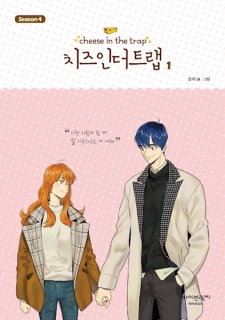Cheese in the Trap is the bowl of confusing, underwhelming, and unevenly-seasoned noodles you buy on a whim one evening after class and force yourself to finish because you did pay for it after all, even if it was only a few dollars, only to discover that all of the seasoning had gathered at the bottom of the bowl and that said seasoning is Actually Very Good even though there are maybe three noodle strands left in your bowl and not much left to do with it, and to leave the restaurant feeling inexplicably happy.
In Cheese in the Trap, if it can be misread, it
...
will be misread. If it can be misunderstood, it will be misunderstood. And if a woman and a man have a conversation with each other, they are in Love and it is everyone’s problem. The ratio of Named Characters Who Are Not A-holes to Named Characters Who Are A-holes is something like 1:7 and stays that way until the very end, and though most, if not all, of our protagonist’s harassers received holy retribution, the question that I left each bloody finale with was: what was the point of taking things so far? Several characters were established as freeloaders/gossips/stalkers/creeps fairly early on in the story. Most followed the same pattern. Offense —> telling-off —> offense —> telling-off —> offense —> telling-off —> offense —> everyone gets bored and stops paying attention to them. Prolonged suffering can be narratively interesting. But most of the suffering in Cheese in the Trap seemed to be for suffering’s sake. Things escalated until Seol, Jung, or someone else hit a breaking point. Is Cheese in the Trap a manhwa about breaking points? I think not.
In other news, this manhwa features a bit of the classic ‘rich, popular dude meets poor, overworked girl’ scenario plus a healthy serving of interpersonal drama. While acknowledging that romcoms tend to be a form of escapism, the focus on what actions the individual can take instead of any influences or pressures on/from society still seemed like a missed opportunity. Being rich is presented as one of two things: a blessing or something that leads to emotional stunting and isolation from your peers. In this framework, Jung’s family can be seen as the personification of financial power. We are shown Jung’s suffering, his hurt, and his frustration, all of which was depicted in a harrowing, raw show of emotion, i.e. Jung’s life is hard because his family is too rich. However, Seol’s suffering, hurt, and frustration can all be chalked up to being too sensitive, too much of a workaholic, or too prone to anxiety, and she finds her peace in learning to relax into her circumstances and embrace the ups and downs. It does not seem to have occurred to the author that Seol’s life might also be hard because her family is too poor. The distribution of sympathy seems off-balance.
The numerous hits to my moral compass aside the real reason I decided to write this review is that in spite of all my complaints (see above), I really liked this story. The author spent essentially three quarters of the story creating a cast of complete trainwrecks who all wanted to see each other rot in hell. If you create a mess you have to deal with it. And against all odds, the author Dealt with it. They reconciled the unreconcilable. They rescued the dead and the abandoned. And they did so with remarkable efficiency, optimism, and style. The revelations that lie at the end of this long, winding path hit me like a gorilla-sized brick in the face and entirely compensated for the pain of watching one particular red-haired clown clown his way through half of the serialization. There were some stellar moments of character development and, that’s right, Communication, and in some ways I think it was being made to suffer through hundreds of chapters of contrived misunderstandings and bad-faith arguments that made clarity so sweet. One line in particular, which I think taken out of context shouldn’t spoil that much, made me sit back in my chair and stare blankly out the window for ten minutes. “I have nothing to give”. Said while sitting on the living room floor, eyes dark, hands empty.
General thoughts! A lot of romance-oriented manga/manhwa/etc has ‘stiff’ artwork and characters that only smile like L’oreal models. Cheese in the Trap’s art style is to die for. If there’s one thing I will vouch for from start to finish, it’s that. Oh, and Seol, whose character development and general attitude towards life is still incredibly inspiring despite the broader social narrative that was lacking. I also acknowledge that alongside the cast of clowns, there are also some gems, some clowns who become gems, and some characters that you’ll want to sit down and drink coffee and cry/fight/commit arson with. It’s surprisingly pessimistic, but it’s also surprisingly optimistic.
So ultimately, is it worth it? I binged the entire thing in four days and don’t feel like I’ve lost too much time I’d want to bargain with god to get back. To summarize, personally:
pros: artwork, characters, authentic slowburn romance
cons: malice-fueled conflict that might make you tear your hair out, characters, weirdly simplistic and also nuanced worldview, an inconsistent moral compass
Cheese in the Trap is, if nothing else, honest. It says what it wants to say. Is it necessarily true? Are your ears bleeding? Yes. But damn if you don’t want to stay for just one more minute, and see where the tides of Accounting and Business Marketing take our cast of four next.
7/10
Alternative TitlesJapanese: 치즈인더트랩 시즌4 InformationType: Manhwa
Volumes: 7
Chapters: 29
Status: Finished
Published: Sep 2, 2015 to Mar 29, 2017
Theme:
School
Serialization:
Naver Webtoon Authors:
Soonkki (Story & Art) Statistics Ranked: #4622 2 based on the top manga page. Please note that 'R18+' titles are excluded. Popularity: #2371
Members: 9,358
Favorites: 187 Resources | Reviews
Filtered Results: 2 / 2
Sort
Your Feelings Categories Jun 16, 2021
Cheese in the Trap is the bowl of confusing, underwhelming, and unevenly-seasoned noodles you buy on a whim one evening after class and force yourself to finish because you did pay for it after all, even if it was only a few dollars, only to discover that all of the seasoning had gathered at the bottom of the bowl and that said seasoning is Actually Very Good even though there are maybe three noodle strands left in your bowl and not much left to do with it, and to leave the restaurant feeling inexplicably happy.
In Cheese in the Trap, if it can be misread, it ... Mar 16, 2020
I'll be doing a short review of all Cheese in the trap, season 1 to 4.
Story ----- 7 What I really enjoy about the story is its pace, there's often foreshadowing and flashbacks. Without them, the story would have no pace. The story itself isn't so good, but not that bad, slice of life mangas don't often have especially good stories. The drama is really, but really good here, it's not some clingy shoujo drama, here it's real shit, but it doesn't seem unreal too, and the reaction seem human-like (not like in other mahwas and manhuas where people don't behave like humans). Art ---- 9 Yes I love ... |


